The stampede at New Delhi Railway Station on Saturday night, which claimed the lives of 18 people and injured many others, is a deeply tragic reminder of the vulnerability of our public transport systems in times of crisis. The incident, which occurred amidst a rush of Maha Kumbh devotees, highlighted a series of preventable lapses—miscommunication, overcrowding, and a lack of adequate infrastructure—that contributed to the chaos and panic.
At the heart of the disaster was a simple yet catastrophic miscommunication. Two trains, both bound for Prayagraj, had nearly identical names—‘Prayagraj Express’ and ‘Prayagraj Special’—and this confusion led to thousands of passengers scrambling across platforms, many with heavy luggage, in a last-minute attempt to catch what they thought was their train. The announcement of the Prayagraj Special arriving at Platform 16, when the Prayagraj Express was already at Platform 14, was a critical trigger. This confusion, compounded by delays of other trains and overcrowding on the platforms, turned what should have been an orderly process into a dangerous, panicked situation.
The narrow stairway leading to the foot overbridge, which connects platforms 14 and 15 to platform 16, proved to be a major bottleneck. It’s distressing to think that this infrastructure, designed to facilitate passenger movement, became the site of a human disaster. The 42-step stairway, leading to a 25-foot-wide footbridge, was simply not equipped to handle the volume of people trying to move in both directions at once. The resulting crush led to the deaths of innocent people, some of whom were as young as 7 and as old as 79.
Also Read: Railways will act against those responsible for New Delhi station stampede: Ramdas
What is most concerning is the response—or lack thereof—in managing the crowd and ensuring safety during such peak times. The Delhi Police’s initial investigation points to multiple factors, including overcrowding exacerbated by delays in train departures and the sale of large numbers of general tickets every hour. The lack of effective crowd control measures at one of the busiest railway stations in India is a stark indictment of the authorities’ failure to anticipate and mitigate risks in a high-stakes environment.
While the Northern Railway authorities have maintained that no platforms were changed and suggested that the cause of the stampede was a passenger who fell on the foot overbridge, it’s clear that this explanation overlooks deeper systemic issues. Overcrowded trains, an outdated public address system, and poor communication only added fuel to an already combustible situation. Witnesses have attested to the confusion that led to the tragedy, and it is vital that the authorities examine how the system can be redesigned to prevent such incidents in the future.
This incident raises a broader question about the state of public transport in India, especially in metropolitan areas like Delhi. As cities grow and millions of people rely on public transport every day, the system needs to evolve to meet the increasing demand. It is not enough to simply build more infrastructure or introduce more trains. The focus must also be on ensuring that these systems are safe, efficient, and capable of handling peak loads without endangering lives.
For instance, a robust crowd control mechanism, clear and consistent communication about train schedules, and upgrades to outdated infrastructure could make a significant difference. Moreover, better coordination between the railway authorities and law enforcement is crucial during peak travel periods. Train stations should also invest in better signage and automated systems to minimize human error and miscommunication.
Additionally, the Indian Railway Catering and Tourism Corporation (IRCTC) and other authorities involved in ticket sales should introduce stricter regulations to curb the sale of excess tickets, especially in cases where the station’s capacity is already stretched thin.
In the wake of this tragedy, the Delhi Police have launched an inquiry into the incident, and officials are investigating potential flaws in the public address system. However, this should only be the beginning. The authorities must now take immediate steps to ensure that the necessary reforms are implemented to avoid similar disasters in the future. This should include better crowd management, the installation of modern, safer infrastructure, and more effective communication systems.
As we mourn the lives lost in this tragedy, let us not forget that these deaths could have been prevented with proper planning, management, and foresight. It is time for our public transportation systems to evolve in ways that ensure the safety and dignity of every passenger.
(This story is sourced from a third-party syndicated feed. Raavi Media takes no responsibility or liability of any nature. Raavi Media management/ythisnews.com can alter or delete the content without notice for any reason.)


